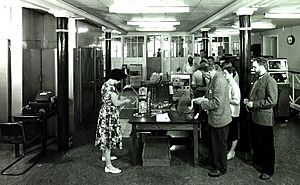EDSAC 2 facts for kids

EDSAC 2 users in 1960
|
|
| Developer | University of Cambridge, Mathematical Laboratory, UK |
|---|---|
| Release date | 1958 |
| CPU | 20-bit instructions with 11-bit addresses, two index registers, microcoded; @ fixed point add: 17-42 microseconds, floating point add: 100-170 microseconds |
| Memory | 1024 words RAM, 768 words ROM (core memory, 40-bit words) |
| Storage | block-structured magnetic tape, 16K words, core memory, added in 1962 |
| Input | 5-level paper tape, up to 1000 characters per second read, 300 cps punched output, two-out-of-five code |
| Predecessor | EDSAC |
EDSAC 2 was an early computer (operational in 1958), the successor to the Electronic Delay Storage Automatic Calculator (EDSAC). It was the first computer to have a microprogrammed control unit and a bit-slice hardware architecture.
First calculations were performed on incomplete machine in 1957. Calculations about elliptic curves performed on EDSAC-2 in the early 1960s led to the Birch and Swinnerton-Dyer conjecture, a Millennium Prize Problem, unsolved as of 2022. And in 1963, Frederick Vine and Drummond Matthews used EDSAC 2 to generate a seafloor magnetic anomaly map from data collected in the Indian Ocean by H.M.S. Owen, key evidence that helped support Plate Tectonic theory.

All content from Kiddle encyclopedia articles (including the article images and facts) can be freely used under Attribution-ShareAlike license, unless stated otherwise. Cite this article:
EDSAC 2 Facts for Kids. Kiddle Encyclopedia.

